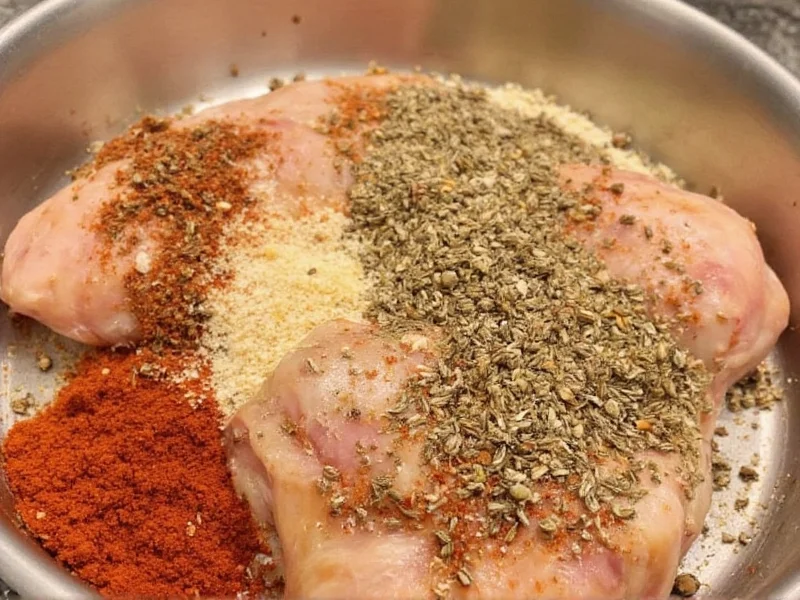Chicken's mild flavor profile makes it the perfect canvas for spice experimentation. Understanding which spices complement chicken's natural taste can transform your cooking from bland to extraordinary. This guide explores the science behind spice pairing with chicken, optimal application techniques, and regional flavor combinations that work consistently across various cooking methods.
The Science of Spice Pairing with Chicken
Chicken has a relatively neutral flavor profile, making it exceptionally versatile with spices. The protein structure of chicken breast differs from dark meat like thighs, affecting how spices penetrate and interact with the meat. White meat benefits from brighter, herbaceous spices that won't overwhelm its delicate texture, while dark meat can handle bolder, earthier seasonings.
When selecting spices for chicken, consider these three factors:
- Oil solubility - Many spice compounds dissolve better in fat, making them ideal for chicken skin or when using oil-based marinades
- Heat stability - Some spices lose flavor at high temperatures, while others develop deeper notes
- Moisture interaction - Certain spices work better in dry rubs versus wet marinades
Essential Spices for Chicken Preparation
While personal preferences vary, these spices consistently deliver excellent results across multiple cooking methods. Each brings unique flavor compounds that complement chicken's natural taste without masking it.
| Spice | Flavor Profile | Best Chicken Applications | Complementary Spices |
|---|---|---|---|
| Paprika (smoked or sweet) | Earthy, slightly sweet, with smoky depth (smoked variety) | Roasted chicken, grilled chicken, chicken paprikash | Garlic powder, onion powder, thyme |
| Garlic powder | Pungent, savory, umami-rich | All chicken preparations, especially pan-seared and roasted | Onion powder, rosemary, lemon zest |
| Dried thyme | Earthy, slightly floral, with subtle mint notes | Roasted chicken, chicken soups, braised dishes | Lemon pepper, garlic, oregano |
| Cumin | Earthy, warm, slightly nutty with citrus undertones | Grilled chicken, tacos, curries, Middle Eastern dishes | Coriander, chili powder, garlic |
| Rosemary | Pine-like, woody, with citrus notes | Roasted chicken, especially with lemon, grilled chicken thighs | Garlic, thyme, olive oil |
Regional Spice Blends for Chicken
Different culinary traditions have perfected spice combinations specifically for chicken. These international blends provide authentic flavor profiles that work exceptionally well with various chicken preparations.
Mediterranean Chicken Seasoning
This versatile blend works beautifully for roasted or grilled chicken. The combination of dried herbs creates a bright, aromatic profile that complements chicken without overwhelming it.
Homemade Mediterranean blend recipe: 2 tbsp dried oregano, 1 tbsp dried thyme, 1 tbsp dried rosemary (crushed), 2 tsp garlic powder, 2 tsp onion powder, 1 tsp lemon zest (dried), 1 tsp black pepper, 1 tsp sea salt.
Latin American Chicken Rub
Perfect for grilled chicken or chicken tacos, this blend incorporates warm spices that caramelize beautifully when cooked.
Authentic Latin chicken rub: 2 tbsp smoked paprika, 1 tbsp cumin, 1 tbsp chili powder, 2 tsp garlic powder, 1 tsp oregano, 1 tsp onion powder, 1 tsp black pepper, 1 tsp dried cilantro.
Optimal Spice Application Techniques
How you apply spices matters as much as which spices you choose. Different techniques yield dramatically different results when preparing chicken.
Dry Rubs vs. Marinades
Dry rubs work best when applied 30-60 minutes before cooking, allowing time for the spices to adhere and begin flavor penetration. For optimal results with dry rubs for chicken thighs or breasts, use approximately 1 teaspoon of spice blend per 4 ounces of chicken.
Marinades incorporating spices benefit from 2-4 hours of contact time. The acid in marinades helps break down proteins, allowing spice flavors to penetrate deeper. When creating spice marinades for chicken, combine your spice blend with oil, acid (like lemon juice or vinegar), and aromatics.
Timing Matters
Add delicate herbs like parsley or cilantro during the last 5-10 minutes of cooking to preserve their fresh flavor. Earthier spices like cumin, coriander, and smoked paprika benefit from being added earlier to allow their flavors to develop during cooking.
Avoiding Common Spice Mistakes
Even with the best spices, improper usage can ruin your chicken dish. These common errors undermine otherwise good seasoning efforts:
- Adding salt too early - While dry brining with salt works well, adding other spices too early can cause them to burn during high-heat cooking
- Overcomplicating blends - Using too many spices creates flavor confusion rather than harmony
- Not adjusting for cooking method - Spices behave differently when grilled versus roasted versus pan-seared
- Using old spices - Ground spices lose potency after 6-12 months; whole spices last longer but still degrade
Creating Your Own Custom Chicken Seasoning
Developing personalized spice blends for chicken allows you to tailor flavors to your specific preferences. Follow this simple framework for creating balanced homemade chicken seasoning recipes:
- Base (40%) - Choose 1-2 primary spices that define the flavor profile (paprika, cumin, etc.)
- Aromatics (30%) - Add garlic, onion, or shallot powder for depth
- Herbs (20%) - Incorporate dried herbs like thyme, oregano, or rosemary
- Accent (10%) - Include one distinctive element (citrus zest, heat element, or unique spice)
Store homemade spice blends for chicken in airtight containers away from light and heat. Properly stored, they maintain optimal flavor for 3-6 months. Always label your blends with the creation date to track freshness.











 浙公网安备
33010002000092号
浙公网安备
33010002000092号 浙B2-20120091-4
浙B2-20120091-4